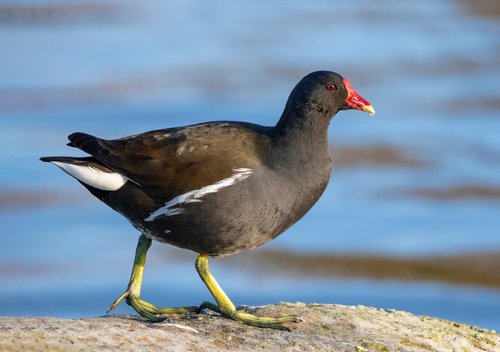
Common Moorhen
The Common Moorhen (Gallinula chloropus) is a widely distributed bird species belonging to the rail family. It's known for its adaptability, thriving in various wetland habitats across the globe. While often mistaken for ducks, moorhens are more closely related to coots and crakes. They play a crucial role in their ecosystems as both predator and prey, contributing to the balance of wetland food webs. The Common Moorhen does not hold significant cultural importance in many regions, but its widespread presence makes it a familiar sight for birdwatchers and nature enthusiasts.
32-35 cm
Length
50-55 cm
Wingspan
Least Concern
Conservation Status
Distribution
Found on every continent except Antarctica and Australia. It has a vast range, including North and South America, Europe, Asia, and Africa. Migratory populations exist in the northern parts of its range, moving south for the winter. Altitudinal range varies from sea level to high-altitude wetlands, depending on the region.
Lifespan
Up to 9 years in the wild, though average lifespan is likely shorter due to predation and other environmental factors.
Common Moorhen's Habitat
Habitat Types
Freshwater marshes, Lakes, Ponds, Slow-moving rivers, Canals, Reedbeds, Well-vegetated wetlands
Climate Zones
Tropical, Subtropical, Temperate
Adaptations
Common Moorhens have partially webbed feet, aiding in swimming and walking on soft mud. Their long toes help distribute their weight, preventing them from sinking into the mud. They are also capable of diving to escape predators or forage for food.
Variations
Numerous subspecies exist, with variations in size and plumage coloration. For example, some island populations are darker than mainland counterparts. Over 12 subspecies are recognized, differing subtly in size and the color of their plumage.
Appearance
Breeding Plumage
Breeding plumage is generally darker and more vibrant, with a brighter red frontal shield and yellow-tipped bill. Non-breeding plumage is slightly duller.
Seasonal Feather Changes
Limited seasonal variation beyond the breeding/non-breeding differences.
Sex Based Plumage Differences
Minimal; males and females have very similar plumage.
Notable Features
Red frontal shield extending from the bill, Yellow-tipped red bill, White undertail coverts with a black central stripe, Long, greenish legs and toes
Diet and Feeding
Primary Foods
Aquatic plants, Seeds, Insects, Small invertebrates, Mollusks, Small amphibians, Occasionally small fish
Foraging Behavior
Forages by walking on floating vegetation, probing in mud, or swimming and dabbling. It also picks food from the water's surface or from plants.
Specializations
No highly specialized feeding adaptations, reflecting its generalist diet.
Seasonal Diet Variations
Diet may shift slightly depending on food availability. For example, they may consume more insects during the breeding season when protein demands are higher.
Behavior
Social Structure
Generally found in pairs or small family groups, but may form larger flocks outside the breeding season. They are not typically highly social.
Communication
Variety of calls, including loud, harsh croaks and clucking sounds, Head-bobbing, Tail-flicking (exposing white undertail coverts)
Migration
Northern populations are migratory, moving to warmer areas for the winter. Southern populations are often resident.
Territorial or Group Behaviors
Highly territorial during the breeding season, defending nesting areas aggressively. Outside of breeding, they are less territorial.
Conservation
Threats
Habitat loss and degradation (wetland drainage), Pollution, Hunting (in some regions), Predation by introduced species (e.g., cats, rats on islands)
Protection Programs
General wetland conservation efforts benefit this species, Protected under various national and international wildlife laws
Local National Laws
Protected under the Migratory Bird Treaty Act in the United States and similar legislation in other countries.
Population Trend
Stable
Population Estimates
Global population estimated to be in the millions, though precise figures are difficult to obtain.
Interesting Facts
They can walk on lily pads.
Their long toes distribute their weight, allowing them to walk on floating vegetation without sinking.
Chicks have small claws on their wings.
These claws help them climb through vegetation before they can fly.
They are surprisingly good fliers, despite their somewhat awkward appearance.
Migratory populations undertake long-distance flights.
Faqs about Common Moorhen
Are Common Moorhens ducks?
No, they are members of the rail family (Rallidae), which also includes coots and crakes. They are more closely related to these birds than to ducks.
What is the red thing on a Common Moorhen's face?
That's the frontal shield, a fleshy extension of the upper bill. It's brighter red during the breeding season.
Where can I see Common Moorhens?
Look for them in well-vegetated freshwater wetlands, such as marshes, lakes, ponds, and slow-moving rivers.
Do Common Moorhens migrate?
Some populations migrate, particularly those in colder climates. Others are resident year-round.
Copyright @ Nature Style Limited. All Rights Reserved.
 English
English